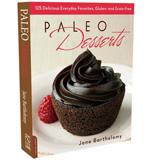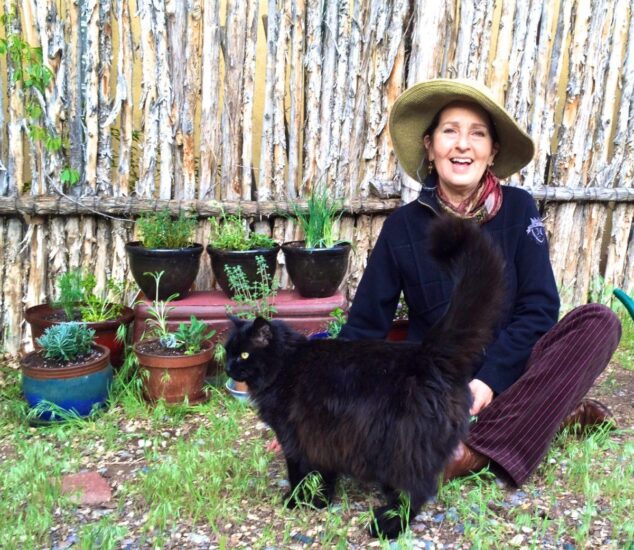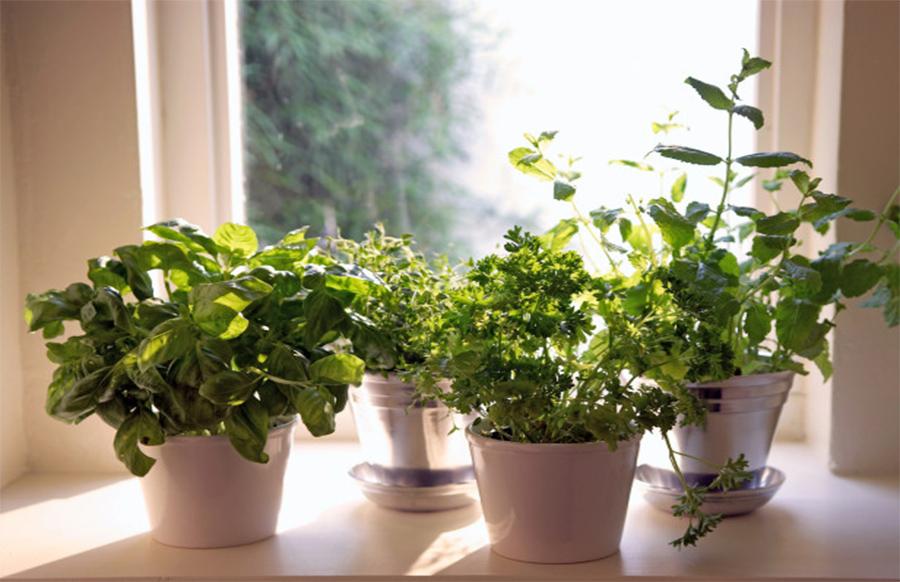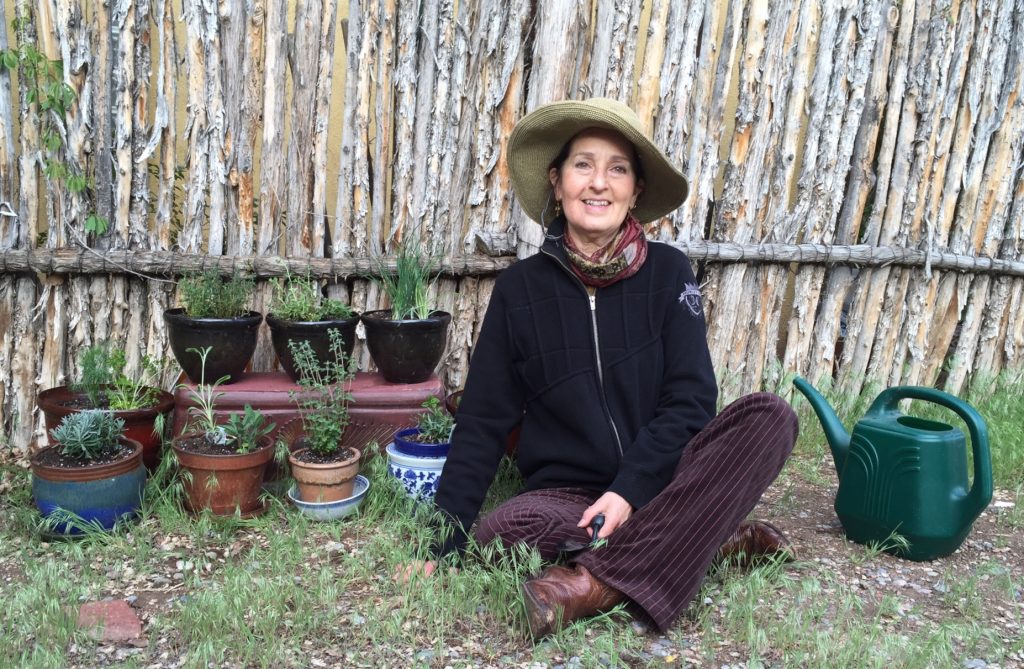Fresh herbs are surprisingly easy to grow, they add aromatic flavor and beauty to your homecooked meals. Another bonus, they contain vitamins and minerals in higher concentrations than many other plants. I find that every dish tastes better with fresh herbs, and the most convenient way to get them is from your own garden, right? Try classic herbs like rosemary, mint, dill, chives, and basil. Or try some of the lesser-known herbs such as oregano, tarragon, marjoram, and lavender. I have simplified this beautiful ritual for you! Here’s how to do it in 5 easy steps.
It’s best to use small pots that fit anywhere.
I want my thyme and dill all year-round! Since herbs are easier to grow than many houseplants, all you need is a set of pots you can lift yourself. Put them outside in a sunny spot or balcony in the warm weather, and bring them inside to a window when it’s cold. In New Mexico where I live, we have surprise freezing nights. I want my herb garden flexible so I can move it inside no matter what the weather.
Here’s my new herb garden. Upper row of 3 left to right: Tarragon, Oregano, Chives. Bottom row: Dill & Parsley, Lavender, Sage, Marjoram, French Tarragon, Mint is behind me.
Step 1: Choose from these favorites, and buy in starters.
Parsley – Contains more vitamin C than almost any other plant. I put parsley in everything – omelets, soups, stir-fries, and oh, don’t forget – Asparagus Gremolata! I just chop and sprinkle parsley on any dish in my kitchen.
Chives – A hardy plant that is best in a pot by itself. It tastes wonderful in Herbed Cream Cheese, salads, and eggs.
Rosemary – Plant in its own pot, and let it dry out between waterings. I love this in meat or chicken dishes. And in Rosemary Olive Bread – this recipe is in my book Good Morning Paleo.
Thyme – It looks like a ground cover. It adds richness to stews and egg dishes, like Paleo Chicken Curry Stew. Enjoy it in the autumn as an aid for the lungs.
Sage – Plant this in it’s own pot. It’s delicious in chicken dishes and sautéed vegetables with grass-fed ghee or butter. Try it in Paleo Chicken Pot Pie or Paleo Biscuits & Gravy
Dill – This traditional European herb tastes wonderful in Authentic Borscht, Paleo-Style.
French Tarragon – Tastes yummy in sauces, like Paleo Mushroom Crepes with Tarragon Cheese Sauce or Artichokes di Campagna with Lemon Tarragon Dip.
Marjoram – A hearty plant related to oregano. It’s delicious in meat dishes. I use it with eggs, mushrooms, hearty vegetables, and it’s especially yummy in Scrambled Eggs Florentine with Dairy-free Cream Cheese!
Oregano – Plant this in a pot by itself so it can spread like a ground cover. Sprinkle liberally (fresh or dried) on your homemade Paleo Pizza.
Mint – Plant it in a larger pot by itself, or it may take over other plants. Delicious in smoothies, tea, salads, Middle Eastern dishes. Try it in Mint Chocolate Mousse and Zucchini Mint Energizer!
Lavender – This hardy Mediterranean plant prefers some rocks underneath the soil. For a sweet treat, try adding 1 to 2 tablespoons finely chopped flowers to Paleo Lemon Ginger No-Sugar Cookies. Or make yourself a relaxing tea with 4 teaspoons chopped lavender flowers and a bit of honey.
Special Note: Why didn’t I choose Basil and Cilantro for my herb garden? After all, these are my favorite herbs! But they’re quite delicate, and can be scorched by the New Mexico sun. I use so much of these two herbs that my little pot can’t keep up. So I buy them at the grocery or Farmer’s Market. If you live in milder weather, try them!
Step 2: Get your supplies. Here’s what you’ll need:
- Large pots, (clay or plastic) 6″ to 10″ inches in diameter See below for pairing options.
- Good potting soil, enough to fill your pots.
- Organic herb fertilizer, or vegetable fertilizer if desired.
- Watering can or hose.
- Trowel and gloves are optional – I used my bare hands.
Step 3: Place starters in the pots to pair and check for size.
Leave your herb starters outside for a few days to get used to the chilly weather, so planting won’t be a shock for them. Choose your pots for size and pairings. Place the starters inside the pots, and plan your planting. Which plants pair well together? Some herbs pair well, and some herbs need their own pot. Pairing suggestions:
Mediterranean Varieties pair well together, as they all need lots of sun and lean, dry soil. These are oregano, sage, thyme, marjoram, rosemary, and lavender.
Moisture-Loving Herbs pair well together, as they like full sun, and need moist soil and a bit more watering, such as basil, cilantro, tarragon and parsley. Parsley lives only two years, so plan on it giving out early.
Mints are spreading herbs that send out runners and grow sideways. They need lots of room in their own pot. Don’t mix different mints in the same box as they’ll interbreed and will create less fragrant varieties.
Step 4: Pot the Herbs and Water well
Fill your pots with good potting soil and add fertilizer according to the directions. Place the pot on a saucer on the ground to catch excess water. Dig a hole large enough for each starter plant. Release the plants from their starter containers by ripping the sides carefully. Or turn upside down, tap the bottom, and gently pull on the base of the stems until the plant comes out of the container. Place the plant in the hole and gently press soil around the edges to fill. Water the plant immediately after planting. Afterwards water them only when the soil feels dry to the touch. Over-watering can be just as bad as under-watering.
Step 5: Place them in a sunny spot, or move inside to a window.
Find a place where your herbs will get at least four hours of sunshine per day. Outside, or on a window ledge, on your balcony, or wherever you want a spot of life. If you live in the desert like I do, keep an eye as some plants may get scorched in the hot afternoon sun. When you’re ready to use the herbs, pinch the tips down so they’ll tend to grow sideways. When the plant reaches 6-8 inches tall, trim about 1/3 of the branches. If you can cut close to a leaf intersection, your plants will regrow very quickly.
I can’t wait to harvest my herbs! Good luck with your own herb garden. Please feel free to send any questions and comments! Fresh is Best!








No Replies to "5 Steps to a Year-round Herb Garden"